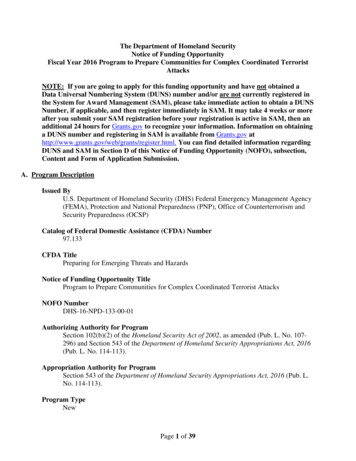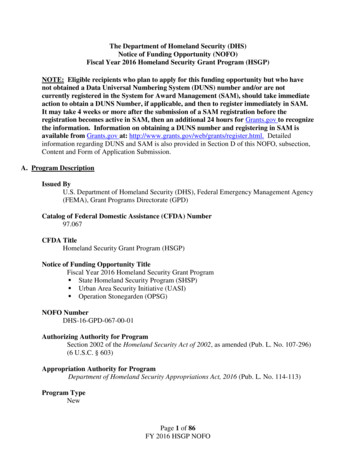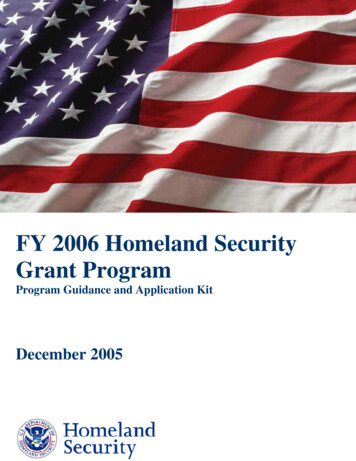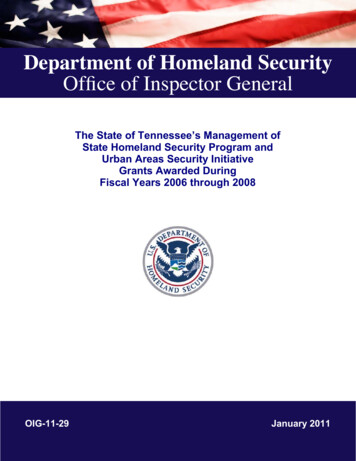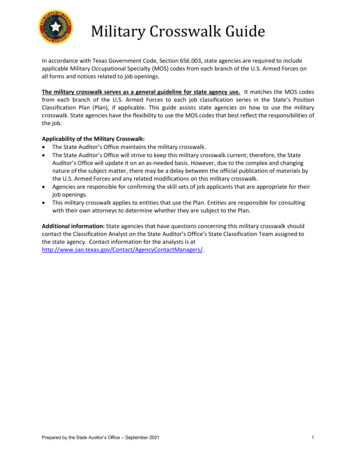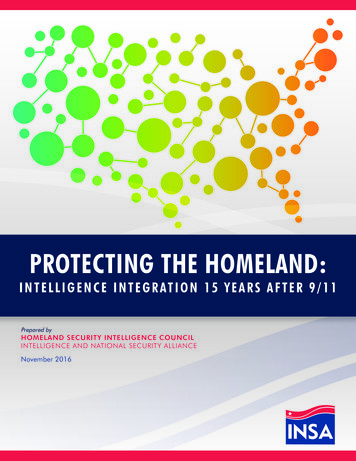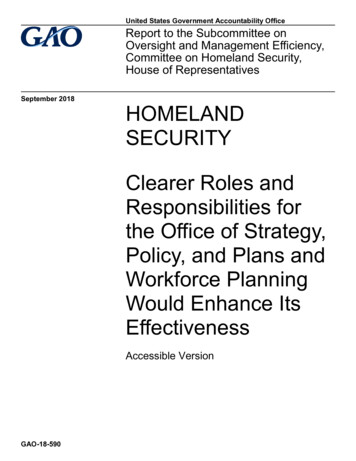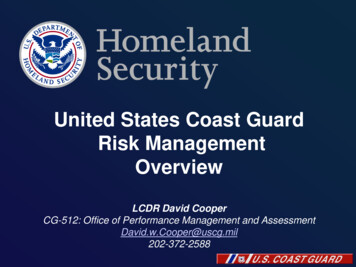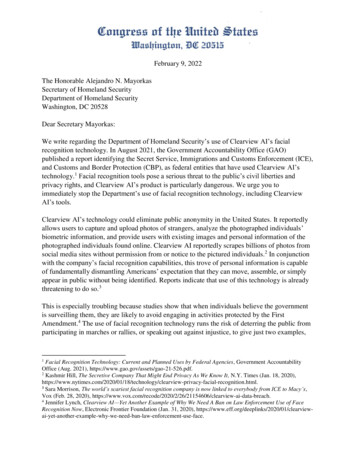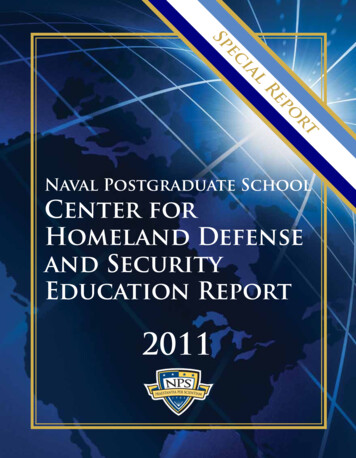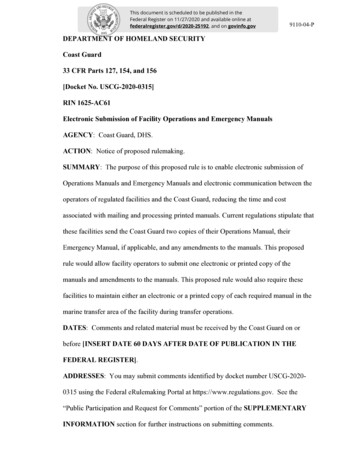
Transcription
This document is scheduled to be published in theFederal Register on 11/27/2020 and available online atfederalregister.gov/d/2020-25192, and on govinfo.gov9110-04-PDEPARTMENT OF HOMELAND SECURITYCoast Guard33 CFR Parts 127, 154, and 156[Docket No. USCG-2020-0315]RIN 1625-AC61Electronic Submission of Facility Operations and Emergency ManualsAGENCY: Coast Guard, DHS.ACTION: Notice of proposed rulemaking.SUMMARY: The purpose of this proposed rule is to enable electronic submission ofOperations Manuals and Emergency Manuals and electronic communication between theoperators of regulated facilities and the Coast Guard, reducing the time and costassociated with mailing and processing printed manuals. Current regulations stipulate thatthese facilities send the Coast Guard two copies of their Operations Manual, theirEmergency Manual, if applicable, and any amendments to the manuals. This proposedrule would allow facility operators to submit one electronic or printed copy of themanuals and amendments to the manuals. This proposed rule would also require thesefacilities to maintain either an electronic or a printed copy of each required manual in themarine transfer area of the facility during transfer operations.DATES: Comments and related material must be received by the Coast Guard on orbefore [INSERT DATE 60 DAYS AFTER DATE OF PUBLICATION IN THEFEDERAL REGISTER].ADDRESSES: You may submit comments identified by docket number USCG-20200315 using the Federal eRulemaking Portal at https://www.regulations.gov. See the“Public Participation and Request for Comments” portion of the SUPPLEMENTARYINFORMATION section for further instructions on submitting comments.
Collection of information. Submit comments on the collection ofinformation discussed in section VI.D of this preamble both to the Coast Guard’s onlinedocket and to the Office of Information and Regulatory Affairs (OIRA) in the WhiteHouse Office of Management and Budget (OMB) using their website . Find thisparticular information collection by selecting “Currently under 30-day Review - Open forPublic Comments” or by using the search function. Comments sent to OMB oncollection of information must reach OMB on or before the comment due date listed ontheir website.FOR FURTHER INFORMATION CONTACT: For information about this documentcall or email Lieutenant Omar La Torre Reyes, Coast Guard; telephone 202-372-1132,email omar.latorrereyes@uscg.mil.SUPPLEMENTARY INFORMATION:Table of Contents for PreambleI.II.III.IV.V.VI.Public Participation and Request for CommentsAbbreviationsBasis and PurposeBackgroundDiscussion of Proposed RuleA. Part 127—Waterfront facilities handling liquefied natural gas and liquefiedhazardous gasB. Part 154—Facilities transferring oil or hazardous materials in bulkC. Part 156—Oil and hazardous material transfer operationsD. Technical revisions within Part 127 and Part 154Regulatory AnalysesA. Regulatory Planning and ReviewB. Small EntitiesC. Assistance for Small EntitiesD. Collection of InformationE. FederalismF. Unfunded MandatesG. Taking of Private PropertyH. Civil Justice ReformI. Protection of ChildrenJ. Indian Tribal GovernmentsK. Energy EffectsL. Technical StandardsM. Environment
I.Public Participation and Request for CommentsThe Coast Guard views public participation as essential to effective rulemaking,and will consider all comments and material received during the comment period. Yourcomment can help shape the outcome of this rulemaking. If you submit a comment,please include the docket number for this rulemaking, indicate the specific section of thisdocument to which each comment applies, and provide a reason for each suggestion orrecommendation.We encourage you to submit comments through the Federal eRulemaking Portalat https://www.regulations.gov. If you cannot submit your material by usinghttps://www.regulations.gov, call or email the person in the FOR FURTHERINFORMATION CONTACT section of this proposed rule for alternate instructions.Documents mentioned in this proposed rule, and all public comments, will be available inour online docket at https://www.regulations.gov, and can be viewed by following thatwebsite’s instructions. Additionally, if you visit the online docket and sign up for emailalerts, you will be notified when comments are posted or if a final rule is published.We accept anonymous comments. All comments received will be posted withoutchange to https://www.regulations.gov and will include any personal information youhave provided. For more information about privacy and submissions in response to thisdocument, see the Department of Homeland Security’s (DHS) eRulemaking System ofRecords notice (Volume 85 of the Federal Register (FR) at 14226, March 11, 2020).We do not plan to hold a public meeting, but we will consider doing so if wedetermine from public comments that a meeting would be helpful. We would issue aseparate Federal Register notice to announce the date, time, and location of such ameeting.II.CFRCOTPAbbreviationsCode of Federal RegulationsCaptain of the Port
�SMEU.S.C.Department of Homeland SecurityFederal RegisterFederal Water Pollution Control ActU.S. Coast Guard Office of Port and Facility ComplianceInformation technologyLiquefied Hazardous GasLiquefied Natural GasMarine Information for Safety and Law EnforcementFacilities that transfer oil or hazardous material in bulkNational Environmental Policy ActNotice of proposed rulemakingOffice of Management and BudgetPerson in charge of transferSmall Business AdministrationSectionSubject matter expertUnited States CodeIII. Basis and PurposeSection 70011 of Title 46 of the United States Code (U.S.C.) authorizes theSecretary of Homeland Security to establish procedures and measures for handling ofdangerous substances, including oil and hazardous material, to prevent damage to anystructure on or in the navigable waters of the United States. Additionally, the FederalWater Pollution Control Act (FWPCA), as amended and codified in 33 U.S.C. 1321(j)(5),authorizes the President to establish procedures to prevent discharges of oil andhazardous substances from vessels, onshore facilities, and offshore facilities. TheFWPCA functions in 33 U.S.C. 1321(j)(5) have been delegated from the President to theSecretary of DHS by Executive Order 12777 Sec. 2(d)(2), as amended by ExecutiveOrder 13286. The authorities in 33 U.S.C. 1321(j)(5) and 46 U.S.C. 70011 (formerly 33U.S.C. 1225) have been delegated to the Coast Guard under section II, paragraphs 70 and73, of DHS Delegation No. 0170.1.The Coast Guard requires all operators of facilities that transfer oil and hazardousmaterials in bulk, to or from certain vessels, to develop and maintain an OperationsManual in order to help prevent discharges of oil and hazardous substances into themarine environment. Operators of facilities that transfer liquefied natural gas (LNG), or
liquefied hazardous gas (LHG) in bulk, to or from a vessel, must also develop andmaintain an Operations Manual and an Emergency Manual. Copies of each manual mustbe submitted to the Coast Guard for review.IV.BackgroundTitle 33 of the Code of Federal Regulations (CFR) part 127 requires facilities thattransfer LNG and LHG in bulk, to or from a vessel, to maintain both an OperationsManual and an Emergency Manual. Similarly, part 154 requires facilities that transfer oilor hazardous materials in bulk, to or from a vessel with a capacity of 39.75 cubic meters(250 barrels) or more, to maintain an Operations Manual.An Operations Manual for either LNG and LHG or oil and hazardous materialstransfer facilities describes how the facility meets applicable operating rules andequipment requirements, and describes the responsibilities of personnel in charge ofconducting transfer operations. An Emergency Manual for LNG and LHG facilitiesdescribes emergency shutdown procedures, fire equipment and systems, contactinformation, emergency shelter information, first aid procedures, emergency proceduresfor mooring and unmooring a vessel, and how the facility would respond to releases ofcargo.According to §§ 127.019 and 154.300, these manuals must be submitted to theCaptain of the Port (COTP) for examination before a facility may operate. Under bothprovisions, the facility operator must submit two copies of each required manual to theCOTP for examination. The COTP evaluates whether the operations and safetyprocedures outlined in the manuals meet the requirements of 33 CFR part 127 (for LNGand LHG) or part 154 (for oil and hazardous material).If these manuals meet the minimum requirements of the regulations, then they areconsidered “adequate.” The COTP accepts the manuals, keeps one copy and returns theother, after marking it “examined.” The facility operator keeps the examined copy and is
required to conduct all operations in accordance with its operations or emergencyprocedures, in accordance with §§ 127.309, 127.1309, or 156.102(t)(2).If the manuals fail to meet the minimum requirements of the regulations, thenthey are considered “inadequate.” The COTP rejects the manuals, and returns the relevantsection, or the entire manual, if necessary, with an explanation of why the procedures in itfailed to meet the relevant regulatory requirements. The operator makes the requiredcorrections and then sends two corrected copies back to the COTP for re-examination.Although the regulations do not explicitly state that the copies must be printed,the requirement for two copies and the return of a marked copy have suggested the use ofprinted documents. The two-copy requirement was issued in 1988 for LNG and LHGfacilities (53 FR 3370, Feb. 5, 1988) and in 1996 for oil and hazardous materials facilities(61 FR 41458, Aug. 8, 1996), when electronic mail and electronic storage were notcommon practice. In practice, operators submit the manuals in printed form.This proposed rule would remove the two-copy requirement and allow facilityoperators to submit one printed or electronic copy of each required manual to the COTPfor examination. It would also allow facilities to maintain either a printed or an electroniccopy of the most recently examined manual(s) in the marine transfer area of the facility.V.Discussion of Proposed RuleThis notice of proposed rulemaking (NPRM) proposes to change the followingsections in title 33 of the CFR: 127.019, 127.309, 127.1309, 154.300, 154.320, 154.325,and 156.120. A section-by-section explanation of the proposed changes follows. SectionV.A discusses the proposed changes to 33 CFR part 127 that would apply to facilities thattransfer LNG and LHG, in bulk, to or from a vessel. Section V.B contains the proposedchanges to 33 CFR part 154 that would apply to facilities that transfer oil and hazardousmaterials, in bulk, to or from a vessel. Section V.C describes the change in 33 CFR part156 which would also allow the oil and hazardous material transfer facilities to maintain
either an electronic or printed copy of the Facility Operations Manual. Finally, in SectionV.D, this proposed rule discusses technical revisions to replace the word “shall” with theplain language terms “must” and “will.”A. Part 127–Waterfront facilities handling liquefied natural gas and liquefiedhazardous gas.Section 127.019 Operations Manual and Emergency Manual: Procedures forexamination.This section currently requires owners and operators of facilities that transferLNG and LHG, in bulk, to or from a vessel to submit two copies of an OperationsManual and an Emergency Manual to the COTP for examination. The revised § 127.019would allow the owners and operators to submit one copy of each manual in printed orelectronic format to the COTP for examination.Additionally, to codify current practices, we propose that manuals submitted afterthe effective date of the final rule include a date, revision date, or other identifyinginformation generated by the facility. All manuals currently have some unique identifyinginformation in them. This provision would allow them to continue to use their ownidentifying information or to use a revision date. The date, revision date, or otheridentifying information would allow the facility operator and the Coast Guard todetermine quickly if the most recent version of the manual is being used. Otheridentifying information generated by the facility may include document control numbersunder an existing internal management system, which make it easier to verify that themost recent version of the manual is being used by the facility.In this section, this proposed rulemaking would modify the manner in which theCOTP notifies the facility operator that the Operations Manual and Emergency Manualhave been examined. Currently, if the manual meets the requirements of this part, theCOTP physically marks the manual “Examined by the Coast Guard” and returns one
copy by mail to the facility operator. In conjunction with requiring only one copy andallowing electronic submission of the manual, we propose allowing the COTP to respondto the facilities electronically to reduce paperwork-processing costs. Under this proposedrule, the COTP would provide notice to the facility that the manual has been examined,and would no longer return a marked copy of the manual to the facility.The COTP would determine the best method to return the notice to the facilityoperator by considering the facility’s available contact information and the method inwhich the manuals were submitted. We expect the COTP’s notice to take the form of aprinted or electronically submitted letter to the facility operator initially, but couldeventually include an electronic certification with the information. The COTP’s noticewould also include the manual’s date, revision date, or other identifying informationgenerated by the facility so that the Coast Guard and facility operators can verify whichmanual is the most recently examined.In proposed § 127.019(e), we would also amend the way the COTP notifies afacility when the manual does not meet the requirements of part 127. Currently, theCOTP is required to return a printed copy of the manual with an explanation of why itdoes not meet the requirements of part 127. This proposed rule would allow the COTP tonotify a facility with an explanation of why it does not meet the requirements of this part,without returning a printed copy of the manual. This proposed change would enableelectronic communication between the Coast Guard and a facility while reducingassociated printing and mailing costs for the Coast Guard. The COTP would retain thediscretion to send the letters and manuals via mail to the facility when appropriate.1Finally, within § 127.019, this proposed rule would remove the word “existing”where it appears in the context of “existing facility” in paragraphs (a) and (b). “Existing”,We use the term “mail” throughout this NPRM to refer to the delivery method used by the Captain of thePort or the facility to send and receive printed copies of letters and manuals. These methods include, but arenot limited to, the United States Postal Service, FedEx, UPS, and courier.1
as applied to a waterfront facility, is defined in § 127.005 “Definitions”, but the definitionis limited to facilities that were constructed before June 2, 1988 for LNG facilities andbefore January 30, 1996 for LHG facilities. The specific dates used within the definitionof “existing” were never intended to apply to the use of “existing” in this section. Toavoid confusion, we propose removing “existing” from this section. The requirements inparagraph (a) would continue to apply to all active facilities, and the requirements ofparagraph (b) would continue to apply to all new or inactive facilities.Section 127.309 Operations Manual and Emergency Manual: Use.Paragraph (a) of this section currently requires the operator of an LNG facility toensure the facility’s Operations Manual and Emergency Manual have both beenexamined by the Coast Guard before LNG transfer operations are conducted. Theproposed revisions to § 127.309(a) would require the operator to ensure that the person incharge of transfer (PIC) has printed or electronic copies of the most recently examinedOperations Manuals and Emergency Manuals readily available in the marine transferarea.The proposed changes to this paragraph enable the PIC to maintain electronic orprinted copies in the marine transfer area. The proposed Operations Manual submissionrequirements in § 127.019 would contain the procedures and requirements for obtainingexamination by the Coast Guard, including the requirement for manuals submitted afterthe effective date of a final rule to have a date, revision date, or other identifyinginformation generated by the facility.In § 127.309, the phrase “readily available in the marine transfer area” means thata printed or electronic copy of the manual is available for viewing within the operatingstation of the PIC. The PIC would not be expected to keep the manual in their possessionwhile conducting routine rounds during a transfer operation.At this time, facilities typically have a printed copy of the examined Operations
Manuals and Emergency Manuals in the marine transfer area. While PICs must know thecontents of the manuals under § 127.301(a)(4), the Coast Guard recognizes that it isdifficult for a PIC to instantly recall every step of every procedure outlined in thesemanuals. Because both § 127.309(b) and (c) require each transfer and emergencyoperation to be conducted in accordance with the examined Operations Manuals andEmergency Manuals, respectively, it is currently common practice for PICs to have acopy of the Operations Manual and Emergency Manual in the marine transfer area duringtransfer operations to reference when needed. Therefore, adding a requirement that aprinted or electronic copy of the most recently examined Operations Manuals andEmergency Manuals must be readily available to the PIC in the marine transfer areawould not add a significant burden to facility operators.Section 127.1309 Operations Manual and Emergency Manual: Use.Similarly, § 127.1309(a) currently requires the operator of an LHG waterfrontfacility to ensure that the facility has an examined copy of the Operations Manual andEmergency Manual prior to any transfer. The proposed changes to § 127.1309(a) wouldrequire, instead, that the facility operators ensure the facility’s PIC has a printed orelectronic copy of the most recently examined Operations Manual and EmergencyManual readily available in the marine transfer area. This proposed change to §127.1309(a) would help ensure that PICs have access to the manuals, if needed, becausethe facility would no longer have a COTP-marked printed copy in the facility. For thepurpose of this section, the phrase “readily available in the marine transfer area” means aprinted or electronic copy of the manual is available for viewing within the operatingstation of the PIC, but the PIC would not be expected to keep the manual in theirpossession.Under § 127.1302(a)(5), LHG facilities, like LNG facilities, typically maintain acopy of the examined Operations Manual and Emergency Manual in the marine transfer
area because the PIC is required to know the contents of the manuals. Additionally, under§ 127.1309(b) and (c), each transfer operation must be conducted in accordance with theexamined Operations Manual. In the event of an emergency, all response efforts must beexecuted in accordance with the examined Emergency Manual. Because of theseknowledge and procedural requirements, it is currently common practice for PICs to havea copy of the Operations Manual and Emergency Manual in the marine transfer areaduring transfer operations to reference in uncommon situations outlined in the manuals.Therefore, adding the requirement explicitly stating that a printed or electronic copy ofthe most recently examined Operations Manual and Emergency Manual must be readilyavailable to the PIC in the marine transfer area should not add a significant burden tofacility operators.B.Part 154–Facilities transferring oil or hazardous materials in bulk.Section 154.300 Operations Manual; General. This section currently requiresoperators of facilities that transfer oil or hazardous materials in bulk to or from a vesselwith a capacity of 39.75 cubic meters (250 barrels) or more to submit two copies of theirOperations Manual to the COTP.We propose to add text to paragraph (a) to clarify that the facility operator mustsubmit the manuals to the COTP of the zone in which the facility operates. The currenttext in paragraph (a) requires facilities to submit their Operations Manual, but does notexplicitly state to whom. The proposed clarification would align the text with currentrequirements and practice.The revised § 154.300 would allow facility operators to submit one printed orelectronic copy of the manual to the COTP with a date, a revision date, or otheridentifying information generated by the facility. This is to allow the facility and theCOTP to determine quickly if the most recent version of the manual is being used duringinspections of the facility. Other identifying information generated by the facility may
include document control numbers under an internal management system, which wouldmake it easier to verify that the most recent version of the manual is being used by thefacility. As the inclusion of such information is current practice, we are only codifyingcurrent practice.We also propose to modify the manner in which the COTP notifies the facilitythat the Operations Manual has been examined. Currently, after examination anddetermination that the manual meets the requirements of this part, the COTP marks themanual “Examined by the Coast Guard” and returns one copy to the facility operator.Under this proposed rule, the COTP would notify the facility that the manual has beenexamined and would no longer return a copy of the manual to the facility. We expect thisnotice to take the form of a printed or emailed letter, initially, with the revision date orother identifying information generated by the facility on the letter, but could eventuallyinclude an electronic certification with the information.Proposed revisions to paragraph (f) of § 154.300 would allow either a printed orelectronic copy of the most recently examined Operations Manual to be readily availablefor each facility’s PIC while conducting a transfer operation. This would effectivelyallow the facility to store the manual in print or electronic format. Additionally, thisproposed rule would allow the facility to have printed or electronic copies of the manualin any translations required under § 154.300(a)(3).In § 154.300(d), the proposed rule would add “products transferred” to the list ofitems the COTP considers when determining whether the manual meets the requirementsof part 154 and part 156. Currently, paragraph (d) indicates that the COTP will considerthe size, complexity, and capability of the facility. Information about the productstransferred, meaning the type of oil and hazardous material, is already required to beincluded in the Operation Manuals under § 154.310(a)(5), and knowledge of the productsbeing transferred is important to reviewing the adequacy of the Operations Manual. The
facility develops their capabilities based in part on the characteristics of the oil orhazardous material they want to transfer. Adding “products transferred” to the list ofconsiderations will increase transparency regarding the manual examination process.Section 154.320 Operations Manual: Amendment.This section addresses amendments to Operations Manuals. Paragraph (a) of thissection states that the COTP may require the facility operator to amend their OperationsManual if the manual does not meet the requirements of this part. This NPRM proposesto change the statement from “requirements of this part” to “requirements of thissubchapter” because there are other regulations in the subchapter that apply to theOperations Manual. The applicable subchapter would be subchapter O, titled “Pollution,”which includes 33 CFR parts 151 through 159.Section 154.320(a)(1) allows facility operators to submit to the Coast Guard anyinformation, views, arguments, and proposed amendments in response to theinadequacies identified by the COTP. In alignment with other changes proposed by thisNPRM, we propose adding language to this section allowing facility operators to sendtheir information, views, arguments, and proposed amendments to the COTP in print orelectronically.In § 154.320(b)(1), this proposed rule would allow facilities to submitamendments to the manuals either in print or electronically. Proposed paragraph (e)would describe how amendments can be submitted and the procedures to follow in theevent the entire manual is submitted for amendments. Currently, amendments aresubmitted as page replacements or as an entire manual, at the option of the submitter,depending on the extent of the changes to the manual. This proposed rule would allow thechoice of page or whole-manual replacement, but would require the inclusion of the date,revision date, or other identifying information generated by the facility.If a facility submits the entire manual with the proposed amendments, this
proposed rule would require that the changes since the last examined manual behighlighted, or otherwise annotated, by the facility. It may be easier for a facility tosubmit the entire manual with the amendments highlighted or annotated, rather thanisolating individual pages that were amended. Examples of ways facility operators couldhighlight or annotate the amendments include use of an electronic or ink highlightingtool, comment or text boxes noting where the changes are, or noting the changes incorrespondence or a document. Ultimately, the method that the facility operator uses canbe anything that identifies all the changes, and is not limited to the methods mentioned inthis preamble. The purpose of highlighting or annotating the amendments is to assist theCOTP in understanding what changes are being made and to reduce the resourcesrequired to examine amendments. After the COTP examines the amendments, the facilitymust maintain the Operations Manual with the most recently examined changes, but therewould be no requirement to keep the changes highlighted or annotated after they areexamined.Currently, § 154.320 paragraphs (b)(2) and (c) state that the COTP will approveor disapprove amendments to manuals, and provide reasons if disapproved. We proposeto align this text with other sections in this part providing that the COTP examines theamendments to manuals for compliance with the subpart, and then notifies the facilitythat the amendments have been examined by the Coast Guard. If the amendments do notmeet the requirements for Operations Manuals in subchapter O, the COTP would notifythe facility operator of the inadequacies and explain why the amendments do not meet therequirements of that subchapter.Section 154.325 Operations Manual: Procedures for examination.This section currently requires facility operators to submit two copies of anOperational Manual to the COTP for examination and outlines the procedures for CoastGuard examination of Operations Manuals for new facilities and facilities that are
removed from caretaker status. The proposed § 154.325 would allow facility operators tosubmit the manual in print or electronic format to the COTP.This NPRM proposes to remove paragraph (a) of § 154.325, which would removethe requirement that the facility operator must submit two copies of the OperationsManual. In alignment with other proposed changes in part 154, the facility operator of anew facility would be able to submit one electronic or printed copy of the OperationsManual to the COTP.In re-designated paragraphs (a) and (b) of this section, the proposed rule wouldclarify that the operator of a new facility or facility removed from caretaker status mustsubmit the manual to the COTP for examination prior to the first transfer operation,rather than prior to any transfer operation. This proposed rule would replace the currenttext “any transfer operation” with “the first transfer operation” to make the regulatorytext more precise. This change clarifies that the facility must submit the OperationsManual prior to a new facility’s first transfer or the first transfer after a facility isremoved from caretaker status.We would amend the process in § 154.325 so that the COTP would notify thefacility when the manual has been examined. Because we are proposing to allowelectronic submission, the COTP would no longer send back a marked printed copy ofthe manual stating it has been examined by the Coast Guard. The COTP’s notice wouldrestate the manual’s date, revision date, or other identifying information provided by thefacility. Where the manual does not meet the requirements of subchapter O, the COTPwould notify the facility with an explanation of why the manual does not meet therequirements of that subchapter. In proposed § 154.325(d) (currently paragraph (e)), thisproposed rulemaking would change for accuracy the text “requirements of this chapter”to “requirements of this subchapter”. The applicable subchapter would be subchapter O,which includes 33 CFR parts 151 through 159.
C.Part 156—Oil and hazardous material transfer operationsSection 156.120 Requirements for transfer.Part 156 contains regulations related to oil and hazardous material transferoperations. Paragraph (t)(2) of § 156.120 currently requires each PIC to have access to acopy of the facility Operations Manual. Proposed § 156.120(t)(2) would require the PICto have either a printed or electronic copy of the most recently examined facilityOperations Manual readily available in the marine transfer area. For the purpose of thissection, “readily available” means that a printed or electronic copy of the manual isavailable for view
maintain an Operations Manual and an Emergency Manual. Copies of each manual must be submitted to the Coast Guard for review. IV. Background Title 33 of the Code of Federal Regulations (CFR) part 127 requires facilities that transfer LNG and LHG in bulk, to or from a vessel, to maintain both an Operations Manual and an Emergency Manual.

